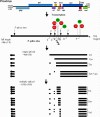The retrovirus RNA trafficking granule: from birth to maturity
- PMID: 16545126
- PMCID: PMC1475878
- DOI: 10.1186/1742-4690-3-18
The retrovirus RNA trafficking granule: from birth to maturity
Abstract
Post-transcriptional events in the life of an RNA including RNA processing, transport, translation and metabolism are characterized by the regulated assembly of multiple ribonucleoprotein (RNP) complexes. At each of these steps, there is the engagement and disengagement of RNA-binding proteins until the RNA reaches its final destination. For retroviral genomic RNA, the final destination is the capsid. Numerous studies have provided crucial information about these processes and serve as the basis for studies on the intracellular fate of retroviral RNA. Retroviral RNAs are like cellular mRNAs but their processing is more tightly regulated by multiple cis-acting sequences and the activities of many trans-acting proteins. This review describes the viral and cellular partners that retroviral RNA encounters during its maturation that begins in the nucleus, focusing on important events including splicing, 3' end-processing, RNA trafficking from the nucleus to the cytoplasm and finally, mechanisms that lead to its compartmentalization into progeny virions.
Figures


References
-
- Fu XD, Katz RA, Skalka AM, Maniatis T. The role of branchpoint and 3' exon sequences in the control of balanced splicing of avian retrovirus RNA. Genes & Development. 1991:211–220. - PubMed
Publication types
MeSH terms
Substances
Grants and funding
LinkOut - more resources
Full Text Sources
Other Literature Sources

